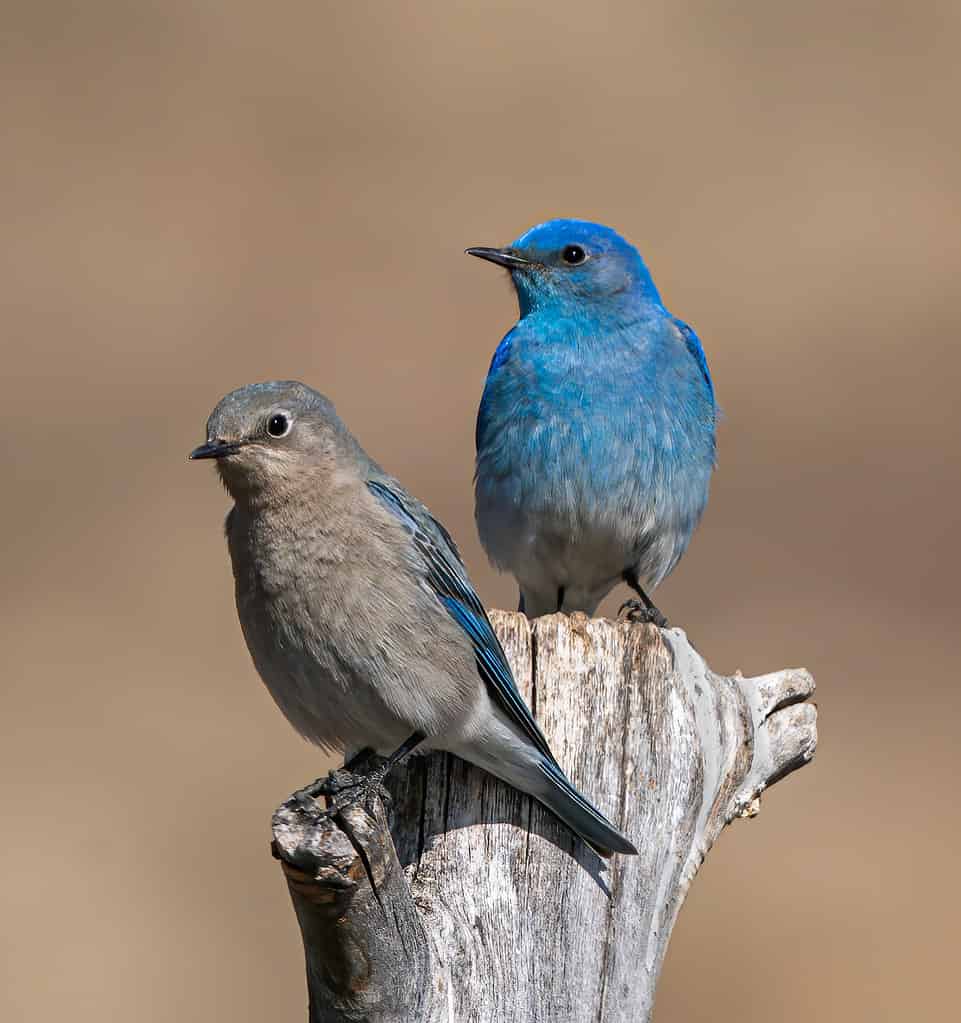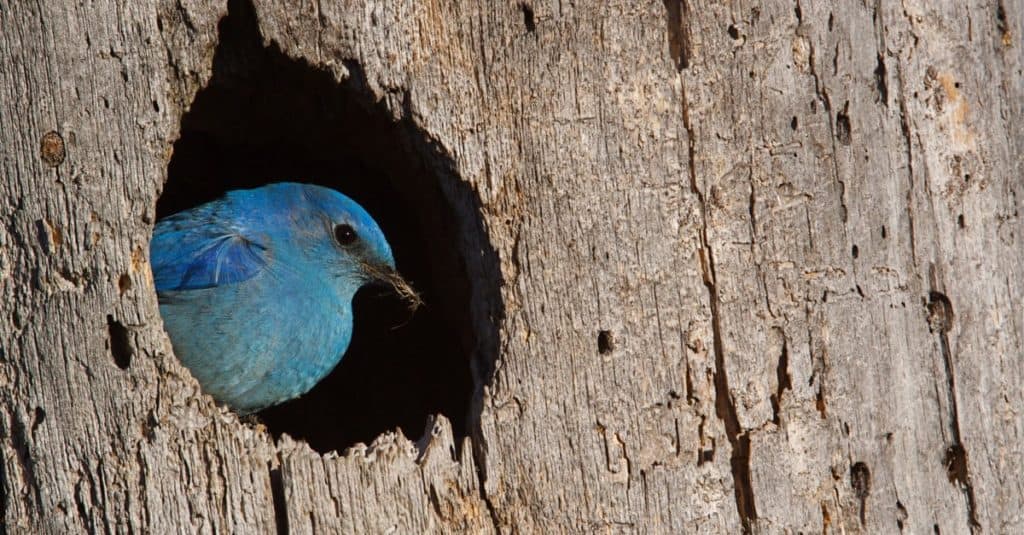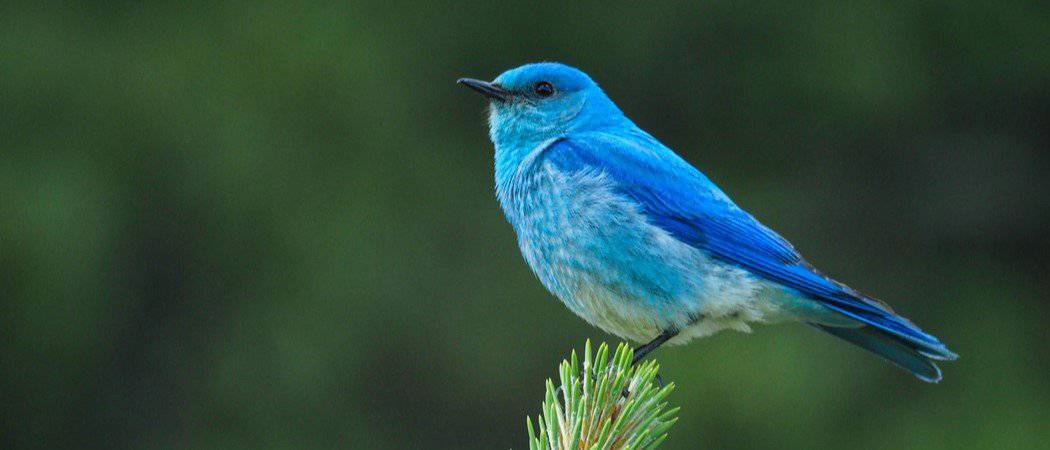The official Idaho State Bird is the Mountain Bluebird (Sialia currucoides). Two different states have chosen the Mountain Bluebird for their official state bird, including Idaho and Nevada. Idaho chose the species in 1931, while Nevada chose the same bird in 1967. School children in the state voted to choose the Mountain Bluebird as the State Bird of Idaho over other possible avian candidates such as the Western Tanager. The state legislature, with the support of the governor, formally recognized the Mountain Bluebird as the Idaho State Bird on February 28, 1931. In addition, the legislature adopted the Peregrine Falcon as the State Raptor of Idaho in 2004.

Where Does the State Bird of Idaho Live?
Mountain Bluebirds employ a breeding range that extends over the entire state of Idaho. According to the Idaho Conservation League, these colorful birds arrive as early as late February or early March and do not leave for their winter grounds until late September to October. The breeding range of the Mountain Bluebird extends from as far south as New Mexico and Arizona, where they are year-round residents, to western Canada and Alaska. Their winter grounds extend south, through the southwest United States and much of Mexico, nearly as far south as Mexico City.
The Mountain Bluebird usually lives at elevations from about 3,250 feet up to about 12,500 feet. It prefers wide, open spaces and often frequents meadows and grasslands, shrublands, steppes, forest edges, and fencerows. Mountain Bluebirds have a high tolerance for human activity, and can often be found in parks and other urban areas, particularly where nest boxes have been provided.

Male and female Mountain Bluebirds are similar in size, but show significant sexual dimorphism in their plumage.
©Richard Seeley/Shutterstock.com
Because Mountain Bluebirds have adapted so well to life alongside human populations, they are a favorite species of many bird enthusiasts and backyard bird watchers. They readily use nest boxes, and they may return to the same nest sites over time. This species does migrate south from Idaho during the colder months, but they return early in the spring. As long as Mountain Bluebirds have access to a secure place to nest, they may choose to be your neighbor their whole life.
Diet

Mountain Bluebirds are adept predators that can easily catch insects on the wing.
©Agami Photo Agency/Shutterstock.com
Mountain Bluebirds are omnivores. They eat mostly insects during the spring and summer. Mountain Bluebirds are adept hunters that can easily catch prey on the wing, on foliage, or on the ground. Their long wings help them hover and swoop in for a quick kill. They eat all sorts of insects, including beetles, flies, grasshoppers, and more. In the winter, when many Mountain Bluebirds move south, they eat a diet consisting of more fruits such as juniper berries and other types of seeds.
Because Mountain Bluebirds have little fear of humans, they generally adapt well to eating from feeders. This species does better with covered feeders than open varieties. They love offerings of meal worms or bits of suet. These foods provide a vital source of protein, especially during winter months when insects are less available. Consider offering these treats in feeders with bowls and covers that prevent larger birds or squirrels from raiding the stash.
Where Does the State Bird of Idaho Nest?

Mountain Bluebirds nest in holes in trees, other small, protected crevices, or nest boxes provided by humans.
©Tom Reichner/Shutterstock.com
Mountain Bluebirds can find many suitable nest sites all over the state of Idaho. They may nest in holes in trees made by woodpeckers, in rock crevices, on buildings or other artificial structures, or in a variety of other small spaces protected from the weather. This species especially prefers nesting in nest boxes if they are available, and they may return to the same nest box over and over to raise new broods.
The State Bird of Idaho arrives in its breeding territory as early as late February. This early arrival proves essential to the success of Mountain Bluebirds, as they can claim nest sites before competing species reach the area. Once a nest site is chosen, the female of the species takes charge of building the nest, while the male actively defends the territory. Both males and females are highly territorial and will defend their nests from intruders during nesting season. They stay in their breeding territory through late September to early October. When they are not nesting, Mountain Bluebirds readily form flocks with others from their species.
Mountain Bluebird Eggs
Mountain Bluebirds produce one or two clutches per year, mating once in the spring and again in the summer. Each clutch averages between four to five eggs, but as many as eight. Mountain Bluebirds may lay light blue eggs or creamy white eggs, but individual birds never lay a mix of colors. Females incubate the eggs for about 13 to 17 days. Afterward, both parents feed and care for the nestlings until they fledge, about 17 to 23 days after hatching. They continue to look after them for another three to four weeks after that, until the fledglings reach full independence.
What Do Mountain Bluebirds Look Like?
The State Bird of Idaho is easy to spot. Bright, cerulean blue Mountain Bluebirds are among the most recognizable birds in North America. These medium sized songbirds from the Turdidae family of thrushes and similar birds reach lengths of approximately 6 to 7 inches. They have long wings, with wingspans of approximately 11 to 14 inches, and long tails. They have thin, straight, black bills and slender black legs and feet.

Female Mountain Bluebirds have turquise wing and tail feathers, and gray plumage on their heads, backs, necks, and breasts.
©Richard Seeley/Shutterstock.com
Male and female Mountain Bluebirds are roughly the same size, but they show significant sexual dimorphism in their plumage. Males are bright, cerulean to turquoise blue with lighter sky-blue throats and breasts and white undersides. They have a thin gray eyeline surrounding their black eyes. Females have turquoise feathers on their wings and tails, with gray plumage on their heads, backs, throats, and breasts, and white undersides near the tail. Their feathers on the breast and flanks may have a brown or reddish-brown tinge in the fall.
Are Mountain Bluebirds Rare?
The State Bird of Idaho is neither rare nor threatened within its home range. According to the IUCN Redlist of Threatened Species, the Mountain Bluebird has a stable and slightly increasing population with the estimated number of adult individuals equaling approximately 6 million birds. The range of this species is vast and not highly fragmented. Mountain Bluebirds have adapted to live in close proximity to humans and have made good use of provided nest boxes throughout their breeding range. This has helped them to overcome habitat degradation in some areas.
The State Raptor of Idaho

Peregrine Falcons can reach speeds of more than 200 miles per hour in flight and are the fastest animals in the world.
©Harry Collins Photography/Shutterstock.com
In 2004, the Idaho State Legislature adopted a second bird as a state symbol. They recognized the Peregrine Falcon (Falco peregrinus) as the State Raptor of Idaho. Peregrine Falcons have a body length of 15 to 20 inches with a wingspan that reaches up to 42 inches or 3.5 feet. These amazing falcons have an extensive range that covers portions of every continent besides Antarctica. Peregrine Falcon has one of the most global distributions of any bird of prey. This falcon is found on every continent except Antarctica, at elevations from sea level up to approximately 12,000 feet. Although Peregrine Falcons only migrate through Idaho, The Peregrine Fund operates the World Center for Birds of Prey in Boise. This species has an important place in the region, which ultimately led to their recognition as Idaho’s State Raptor.
Thank you for reading! Have some feedback for us? Contact the AZ Animals editorial team.








